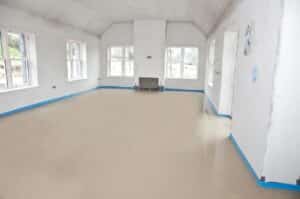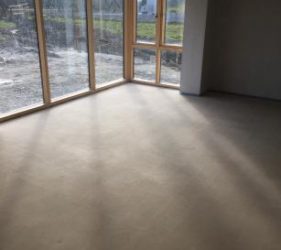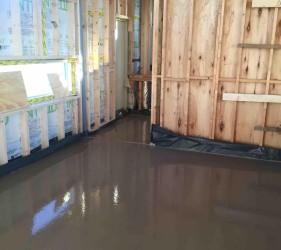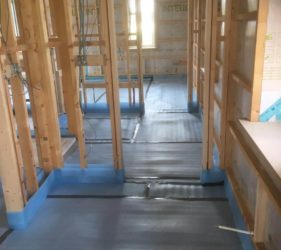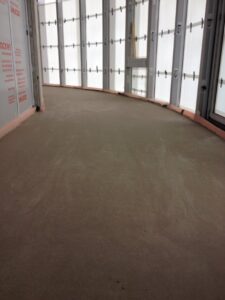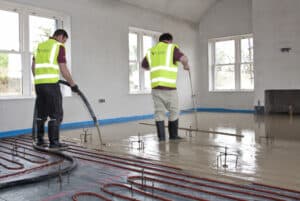FAQs
What is the minimum depth your screed can be applied over insulation?
Our CE certified, EPD approved Sudanit 280 Alpha Hemihydrate flowing screed can be applied over insulation (floating application) either thermal or acoustic at a depth of 35mm in domestic applications and 40mm in commercial applications. In combination with Underfloor Heating (UFH) the minimum cover required over the pipe is 25mm, as per BS 8204-7.
I need my floor re-levelled, what are my options?
Depending on your substrate or subfloor, we can re-level your floor in a bonded, un-bonded, or floating application (over insulation) from 0.5mm up to 100mm. Please call us or use our contact Fast Floor Screed form and we will arrange a site visit in order to determine the best solution.
What are the relevant Floor Screed Standards?
EN 13813: 2002 Screed material & floor screeds – Screed material – Properties & requirements
EN 13454-1: 2004 Binders, composite binders, and factory-made mixtures for floor screeds based on calcium sulphate
BS 8204-1: 2003 Screeds, bases and in situ floorings. Concrete bases and cementitious levelling screeds to receive floorings – Code of practice
BS 8204-2: 2003 Screeds, bases and in situ floorings. Concrete wearing surfaces – Code of practice
BS 8204-3: 2004 Screeds, bases and in situ floorings. Polymer-modified cementitious levelling screeds and wearing screeds – Code of practice
BS 8204-4: 2004 Screeds, bases and in situ floorings. Cementitious terrazzo wearing surfaces – Code of practice
BS 8204-5: 2004 Screeds, bases and in situ floorings. Mastic asphalt underlays and wearing surfaces – Code of practice
BS 8204-6: 2008 Screeds, bases and in situ floorings. Synthetic resin floorings – Code of practice
BS 8204-7: 2003 Screeds, bases and in situ floorings. Pumpable self-smoothing screeds – Code of practice
How long does it take your Alpha-Menihydrate Screed to dry?
Our Screed can be walked on after approx 6 hours, follow-on trades can re-enter the area the next day. Thicknesses up to 40mm will dry at a rate of 1 day per mm thickness, thicknesses larger than 40mm will dry at a rate of 2 days per mm thickness. However, our Alpha Hemihydrate floor screed can be force dried either by switching on the underfloor heating or by utilising a dehumidifier. Please download our After Care datasheet from the Fast Floor Screed Downloads section.
Do you have a screed available for my first floor?
Our Screed is suitable floor application of timber suspended floors, hollow core slabs or insitu poured floors. Because our screed can be installed at much-reduced thicknesses, it weighs significantly less than a traditional sand & cement screed. You might want to consider installing acoustic insulation first in order to reduce footfall noise pollution. We are approved installers for LiteFlo®, the first lightweight pumpable Alpha Hemihydrate screed available, which reduces weight even further by 30%! We can supply and fit at competitive rates. Please click here to contact Fast Floor Screed regarding a quote for LiteFlo® Lightweight Flowing Screed.
What is CASEA Südanit 280 Alpha Hemihydrate Screed?
Pump-applied and self-levelling, Südanit 280 Alpha Hemihydrate Screed is the most technologically-advanced floor screed available, complying with the performance requirements of I.S. EN 13813. What makes Südanit 280 Alpha Hemihydrate Screed so special is its chemical composition. Developed in one of Europe’s most advanced laboratories, then tried and tested over many years of successful application, Südanit 280 Alpha Hemihydrate Screed is a Hemihydrate Screed, and this provides unique benefits over less advanced compounds.
For example, when Südanit 280 Alpha Hemihydrate Screed it is mixed on-site to create a self-levelling, pumpable screed, it takes up the water much more readily than a conventional synthetic Anhydrite Screed, mixing more smoothly and almost completely crystallising – up to 95% in 24 hours, rather than the 70% crystallisation over 7 days for an Anhydrite. This means that Südanit 280 Alpha Hemihydrate Screed is resistant to subsequent wetting, whereas synthetic Anyhydrite Screeds can swell and crack.
Südanit 280 Alpha Hemihydrate Screed is suitable for floors in homes, offices, public buildings, and places exposed to similar loads. Südanit 280 Alpha Hemihydrate Screed is specially designed for floating floor applications i.e. over underfloor heating and over acoustic/thermal insulation boards. Südanit 280 Alpha Hemihydrate Screed should be covered with a floor finish such as tiles, linoleum, parquet, cork, or carpet.
Can you show me How you Screed my Floor?
What are the Benefits of a Screed floor fitted by Fast Floor Screed Ltd?
- Perfectly level floors – every time
- Reduced screed thickness – maximises insulation thickness
- Improved U-Values
- Increased performance of underfloor heating (UFH)
- No shrinkage or curling
- Can be used for acoustic (dB) flooring
- Application is Extremely Fast – Applied At 500m² Per Day and Walkable in 6 Hours
- Can be force dried
- No additional finishing required before final floor coverings are laid
- Alpha Hemihydrate Screed is stable and does not segregate
- No surface skin formation, unlike less superior synthetic Anhydrites compounds
- Much faster to apply and significantly lighter than traditional sand & cement
- Mixed on-site and professionally machine pumped in-situ by our experienced team
- We use laser levelling tripod system to expertly lay the flattest floor possible
- Installed in strict accordance with BS 8204-7 code of practice
- Alpha Hemihydrate Screed binder complies with EN 13454-1: 2004, CE marked
- Product mixed on-site – no mess – no fuss
- Extremely tidy workmanship – all you’ll be left with will be a superbly flat smooth floor
- A full pre-site survey undertaken, with a no-obligation quote
- After Sales Services, including accurate Moisture Testing
What is LiteFlo® Screed?
The construction industry is often thought of as slow to respond to changes, however, the development of self levelling floor screed quickly gained acceptance for its speed of laying, drying, ease of labour and, that holy grail of building – a level surface. Concrete is heavy stuff though, and the self-levelling screeds currently available often require a correspondingly robust structure to support them. The development of innovative LiteFlo®, a lightweight alpha hemihydrate calcium sulphate floor screed from SMET changes that. Made from specially selected aggregates which make it 30% lighter than conventional flowing screeds, it is pump applied and therefore ideal for timber frame builds, tower buildings, balconies, suspended timber floors, renovation projects, and for over acoustic or thermal insulation.
Further, selecting the right floor screed can play a key role in a building’s sustainability. According to Joris Smet, director of Smet Building Products Ltd, the company’s German-made, CE-marked LiteFlo® floor screed combines improved thermal performance with reduced environmental impact, making it possible to install underfloor heating in applications where it may have been ruled out, such as retrofits and multi-storey timber frame buildings.
LiteFlo® is unique, in that it’s the first pumpable lightweight flowing screed available. It’s made from specially selected aggregates, which makes it 30% lighter than conventional flowing screeds and 70% lighter than sand & cement, meaning less material is required per m2. Lightweight flowing screed can be placed in reduced thicknesses, delivering improved floor U-values, and naturally has substantially lower embodied carbon emissions than a sand & cement screed.
A lightweight alpha hemihydrate screed, LiteFlo® is a self-levelling screed based on calcium sulphate. It is pump-applied, therefore ideal for timber frame builds, suspended timber floors, tower buildings, balconies, renovation projects, and over acoustic or thermal insulation. LiteFlo®’s low weight enables underfloor heating to be installed in multi-storey timber frame buildings, and its reduced thicknesses mean underfloor heating can be retro-fitted without substantially raising floor levels.
Benefits of SMET LiteFlo® Lightweight Flowing Floor Screed
· Lightweight – high yield, 43kg per m2 @ 40mm thickness
· Pumpable – first of its kind available
· 30% weight reduction compared to standard calcium sulphate screeds
· 70% weight reduction compared to traditional sand & cement
· Ideal for application in high-rise buildings
· Ideal for over timber suspended floors in new builds and renovations
· Smooth laitance free finish
· For application at thicknesses of between 20 and 90mm
· Under Floor Heating – full-encapsulation
· Perfectly level floors – every time
· German manufactured to CE EN 13813: 2002
What about running the Underfloor Heating – UFH?
Did you know…? Fast Floor Screed Ltd Alpha Hemihydrate Screed can be installed in a heated floating-floor screed construction, uniquely, with the commissioned underfloor heating system up and running at 25°C?! Even further reducing drying times with the floor screed dry in 8 days!
How should I prep my Floor prior to Screeding?
Check out this handy Fast Floor Screed Ltd UFH with Screed Preparation Guide
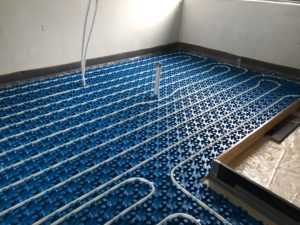
Fast Floor Screed Mobile screed factory for Cooldine Construction Tipperary – good prep makes all the difference
How should we TILE on this Calcium Sulphate Alpha Hemihydrate Floor Screed:
Open this link for a comprehensive overview of how to TANK and TILE and which products to use. Your one-stop guide from SMET on all things TANKING and TILING
SMET TANKING and TILING_ System E-BOOKWhat is Calcium Sulfate?
Calcium Sulphate or Calcium Sulfate is a common laboratory and industrial chemical. In the form of γ-anhydrite (the nearly anhydrous form), it is used as a desiccant. It is also used as a coagulant in products like tofu. In the natural state, unrefined calcium sulfate is a translucent, crystalline white rock. When sold as a colour-indicating variant under the name Drierite, it appears blue or pink due to impregnation with cobalt chloride, which functions as a moisture indicator. The hemihydrate (CaSO4·~0.5H2O) is better known as plaster-of-Paris, while the dihydrate (CaSO4·2H2O) occurs naturally as gypsum. The anhydrous form occurs naturally as β-anhydrite. Depending on the method of calcination of calcium sulfate dihydrate, specific hemihydrates are sometimes distinguished: alpha-hemihydrate and beta-hemihydrate. They appear to differ only in crystal size. Alpha-hemihydrate crystals are more prismatic than beta-hemihydrate crystals and, when mixed with water, form a much stronger and harder superstructure.

